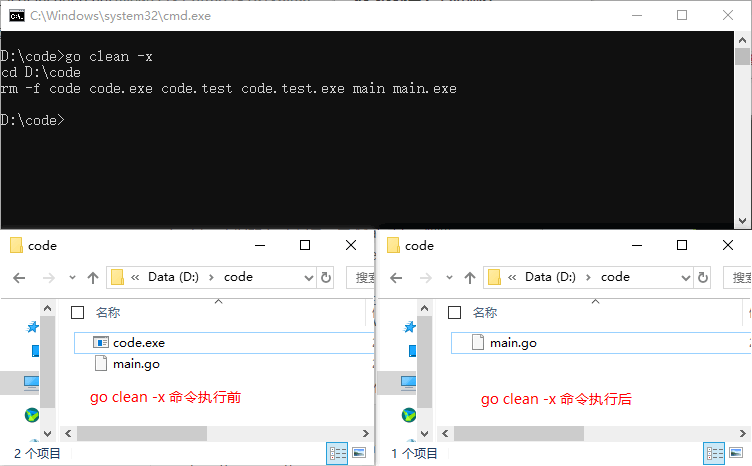What is the use of go clean?
In the Go language, the "go clean" command is used to remove files compiled and generated in the current source code package and associated source code packages. The removed files can be: 1. An executable file with the same name as the package name or source code file generated in the current directory when executing the "go build" command; 2. When executing the "go test" command and adding the "-c" flag A file generated in the current directory with the package name plus ".test" suffix; 3. The result file generated when executing the "go install" command to install the current code package, etc.

The operating environment of this tutorial: Windows 10 system, GO version 1.18, Dell G3 computer.
The go clean command in Go language can remove the compiled and generated files in the current source code package and associated source code packages. These files include the following:
The executable file with the same name as the package name or Go source file is generated in the current directory when the
go build command is executed. Under Windows, it is a file with the same name as the package name or Go source code file and with the ".exe" suffix.- The package name generated in the current directory when executing the
go test
command and adding the-ctag is named after the package name plus the ".test" suffix. document. Under Windows, it is a file with the package name plus ".test.exe" suffix. - The result file generated when executing the
go install
command to install the current code package. If the current code package only contains library source files, the result file refers to the corresponding archive file in the pkg directory of the workspace. If the current code package contains only one command source code file, the result file refers to the executable file in the bin directory of the workspace. - Files or directories left in the corresponding directory when compiling Go or C source code files. Includes: "_obj" and "_test" directories, files named "_testmain.go", "test.out", "build.out" or "a.out", named with ".5", ".6" , ".8", ".a", ".o" or ".so" as the suffix. These directories and files are generated in the temporary directory when executing the
go build
command.
go cleanThe command can also specify some parameters. The meaning of the corresponding parameters is as follows:
-i
Clear the associated installed packages and executable files, that is, throughgo installInstalled files;-n
Print out the cleanup command that needs to be executed, but do not execute it, so that you can easily know how the bottom layer is running. ;-r
Circular clearing of packages introduced inimport;-x
prints out the detailed command executed, which is actually the execution version printed by-n;-cache
deletes allgo buildCommand cache-testcache
Delete all test results of the current package
go clean command is used to clear the compiled files, and then the source code is submitted to github to facilitate the management of the source code.
go clean -n cd D:\code rm -f code code.exe code.test code.test.exe main main.exe
go clean -x cd D:\code rm -f code code.exe code.test code.test.exe main main.exe
 Figure: Comparison before and after running the go clean command
Figure: Comparison before and after running the go clean command
Go video tutorial, Programming teaching]
The above is the detailed content of What is the use of go clean?. For more information, please follow other related articles on the PHP Chinese website!

Hot AI Tools

Undresser.AI Undress
AI-powered app for creating realistic nude photos

AI Clothes Remover
Online AI tool for removing clothes from photos.

Undress AI Tool
Undress images for free

Clothoff.io
AI clothes remover

Video Face Swap
Swap faces in any video effortlessly with our completely free AI face swap tool!

Hot Article

Hot Tools

Notepad++7.3.1
Easy-to-use and free code editor

SublimeText3 Chinese version
Chinese version, very easy to use

Zend Studio 13.0.1
Powerful PHP integrated development environment

Dreamweaver CS6
Visual web development tools

SublimeText3 Mac version
God-level code editing software (SublimeText3)

Hot Topics
 1386
1386
 52
52
 What is the problem with Queue thread in Go's crawler Colly?
Apr 02, 2025 pm 02:09 PM
What is the problem with Queue thread in Go's crawler Colly?
Apr 02, 2025 pm 02:09 PM
Queue threading problem in Go crawler Colly explores the problem of using the Colly crawler library in Go language, developers often encounter problems with threads and request queues. �...
 What libraries are used for floating point number operations in Go?
Apr 02, 2025 pm 02:06 PM
What libraries are used for floating point number operations in Go?
Apr 02, 2025 pm 02:06 PM
The library used for floating-point number operation in Go language introduces how to ensure the accuracy is...
 How to solve the user_id type conversion problem when using Redis Stream to implement message queues in Go language?
Apr 02, 2025 pm 04:54 PM
How to solve the user_id type conversion problem when using Redis Stream to implement message queues in Go language?
Apr 02, 2025 pm 04:54 PM
The problem of using RedisStream to implement message queues in Go language is using Go language and Redis...
 In Go, why does printing strings with Println and string() functions have different effects?
Apr 02, 2025 pm 02:03 PM
In Go, why does printing strings with Println and string() functions have different effects?
Apr 02, 2025 pm 02:03 PM
The difference between string printing in Go language: The difference in the effect of using Println and string() functions is in Go...
 What should I do if the custom structure labels in GoLand are not displayed?
Apr 02, 2025 pm 05:09 PM
What should I do if the custom structure labels in GoLand are not displayed?
Apr 02, 2025 pm 05:09 PM
What should I do if the custom structure labels in GoLand are not displayed? When using GoLand for Go language development, many developers will encounter custom structure tags...
 What is the difference between `var` and `type` keyword definition structure in Go language?
Apr 02, 2025 pm 12:57 PM
What is the difference between `var` and `type` keyword definition structure in Go language?
Apr 02, 2025 pm 12:57 PM
Two ways to define structures in Go language: the difference between var and type keywords. When defining structures, Go language often sees two different ways of writing: First...
 Which libraries in Go are developed by large companies or provided by well-known open source projects?
Apr 02, 2025 pm 04:12 PM
Which libraries in Go are developed by large companies or provided by well-known open source projects?
Apr 02, 2025 pm 04:12 PM
Which libraries in Go are developed by large companies or well-known open source projects? When programming in Go, developers often encounter some common needs, ...
 How to ensure concurrency is safe and efficient when writing multi-process logs?
Apr 02, 2025 pm 03:51 PM
How to ensure concurrency is safe and efficient when writing multi-process logs?
Apr 02, 2025 pm 03:51 PM
Efficiently handle concurrency security issues in multi-process log writing. Multiple processes write the same log file at the same time. How to ensure concurrency is safe and efficient? This is a...




